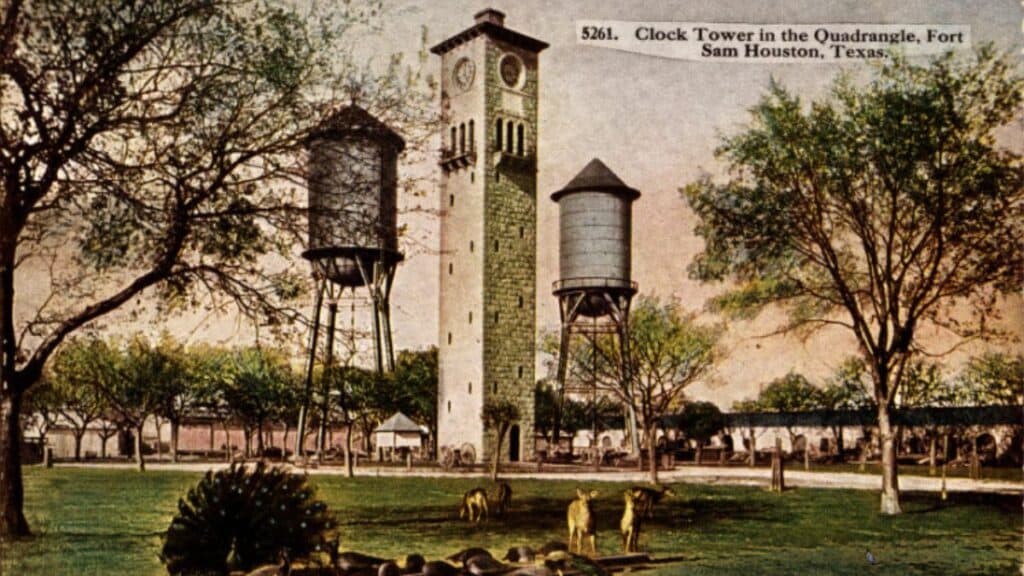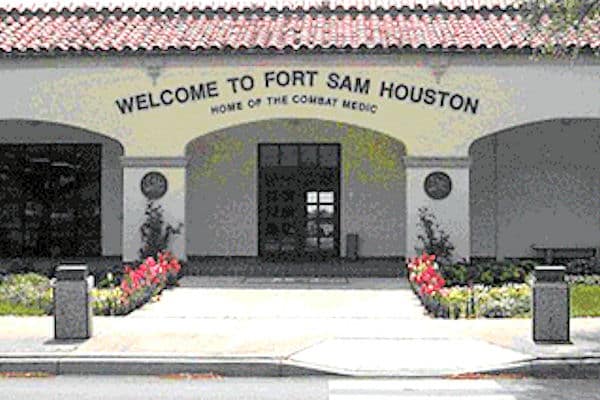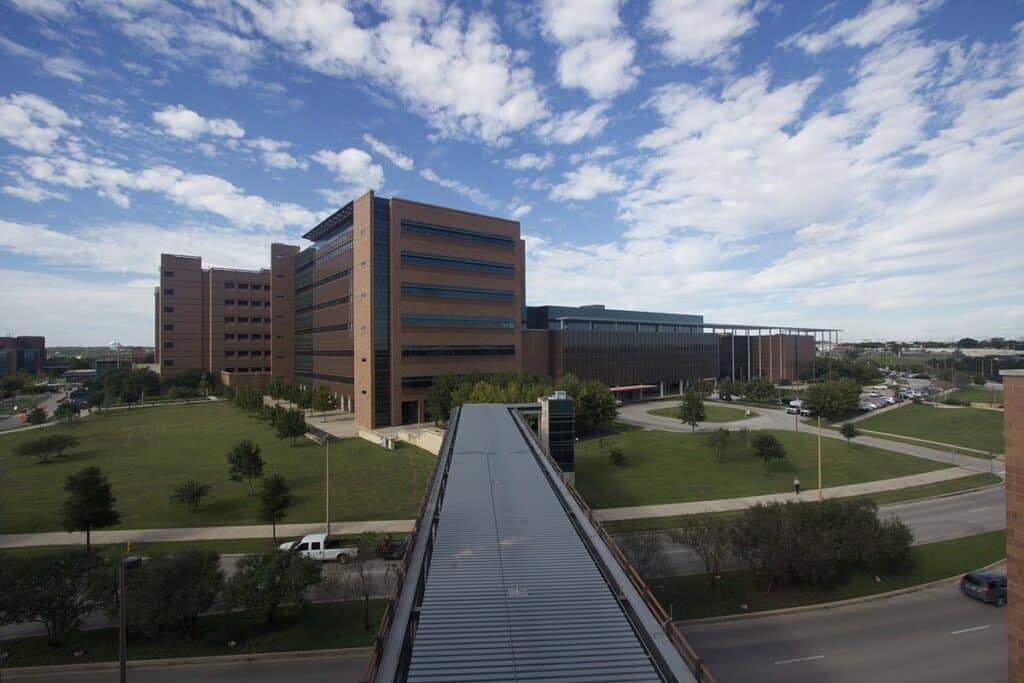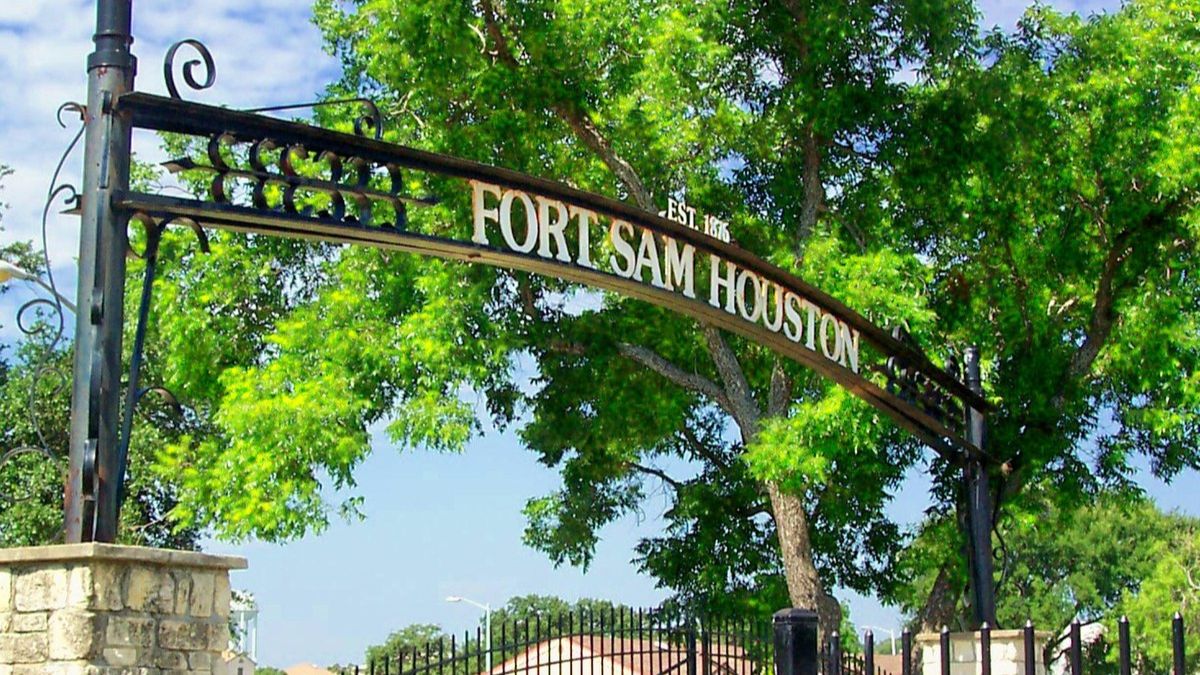Fort Sam Houston in San Antonio, Texas, is a pivotal military hub with a rich and significant history. Established during the Republic of Texas era, it has been central to many key events, including World War I and II.
Originally a small installation, it quickly grew to meet the demands of a burgeoning region and became a permanent military post in 1876.
Its strategic importance continued through World Wars, serving as a critical training ground and medical center.
Today, as a National Historic Landmark, it balances its active military role with historical preservation, offering a unique glimpse into America’s military past and present.
History of Fort Sam Houston (Texas)

Fort Sam Houston in San Antonio, Texas, has a long and storied history. Established during the Republic of Texas, it has played key roles in multiple significant events and conflicts, including World War I.
Origins and Early History
Fort Sam Houston was named after Sam Houston, a prominent figure in Texas history. The fort was established in the mid-19th century to protect settlers and maintain order in the growing region.
Initially, it began as a small military installation in San Antonio but quickly became important.
The Battle of San Jacinto, where Sam Houston defeated Mexican forces, is a notable historical backdrop. This battle emphasized the need for a strong military presence in Texas.
As such, Fort Sam Houston became a central hub for military operations in the area and was officially designated a permanent military post in 1876.
Role in World Wars
Fort Sam Houston became a critical training ground for soldiers heading to Europe during World War I.
The fort expanded its facilities to accommodate the influx of troops, transforming into one of the busiest military bases in the United States.
The installation included officer training camps, medical training facilities, and supply depots.
The fort’s importance continued through World War II, when it again served as a primary training and medical treatment center.
Many soldiers and medical professionals passed through its gates, contributing to the Allied war efforts. The fort’s strategic location and robust infrastructure made it an indispensable asset during these global conflicts.
National Historic Landmark Designation
1975 Fort Sam Houston was designated a National Historic Landmark, recognizing its rich historical importance.
This designation highlighted the fort’s contributions to military history and its well-preserved architecture. Buildings like the Quadrangle and the historic officers’ quarters were key to this recognition.
The fort’s landmark status has helped preserve its historic structures.
Fort Sam Houston remains an active military installation and a historical site open to the public today. This balance of present-day use and historical preservation makes it unique among military bases.
Organizational Structure
Fort Sam Houston hosts crucial elements of the U.S. military, including key army commands and medical departments. Each component plays a significant role in both national and international military operations.
U.S. Army North

U.S. Army North, part of the United States Northern Command, focuses on homeland defense, civil support operations, and security cooperation.
Its primary duty is to defend domestic territory and provide assistance during natural disasters and emergencies.
Located at Fort Sam Houston and incorporating the 502d Air Base Wing, U.S. Army North coordinates with the Department of Defense and other federal agencies.
It also engages in training and readiness programs to prepare forces for potential threats and emergencies.
U.S. Army South
U.S. Army South, operating under the United States Southern Command, is responsible for security cooperation, peacekeeping, and military operations in Central and South America.
Its mission includes building partnerships with Latin American countries to promote stability and security.
Headquartered at Fort Sam Houston, this command plays a pivotal role in regional security.
It conducts various exercises and joint operations with partner nations to enhance collective defense capabilities. U.S. Army South’s efforts help foster international cooperation and improve military readiness in the Western Hemisphere.
Army Medical Department
The Army Medical Department (AMEDD) at Fort Sam Houston leads the U.S. Army’s medical support, ensuring soldiers’ health and readiness.
This department includes multiple organizations that provide comprehensive healthcare, medical research, and education.
AMEDD encompasses the U.S. Army Medical Command, responsible for healthcare delivery and medical logistics.
It also includes training institutions like the U.S. Army Medical Department Center and School, which prepare military medical personnel.
By centralizing medical services and training, AMEDD ensures efficient and effective healthcare for military personnel worldwide. Its presence at Fort Sam Houston underscores the base’s critical role in medical support for the U.S. Army.
Military Training and Education

Military training and education are pivotal to preparing personnel for their roles at Fort Sam Houston.
This encompasses specialized medical education, advanced medical department training, and dedicated training for combat medics.
Medical Education and Training Campus
The Medical Education and Training Campus (METC) at Fort Sam Houston is a consolidated center for enlisted medical training. It trains members from all branches of the military and focuses on a variety of medical specialties.
Courses include instruction on medical procedures, patient care, and emergency response.
Advanced simulation technologies provide realistic training scenarios to enhance learning experiences. The campus boasts modern facilities and a diverse program range, ensuring comprehensive medical education.
Army Medical Department Center and School
The Army Medical Department Center and School (AMEDDCS) focuses on developing medical professionals for the Army.
It provides education for both officers and non-commissioned officers, covering medical, dental, veterinary, and health services administration.
Training incorporates classroom instruction and hands-on practice. AMEDDCS emphasizes leadership development and advanced medical knowledge.
Graduates are well-prepared to manage medical operations in various environments, from hospitals to combat zones.
Combat Medic Training
Combat Medic Training at Fort Sam Houston equips medics with critical skills needed for battlefield care.
The program includes rigorous physical training, medical procedures, and trauma care techniques.
Combat medics learn to stabilize and evacuate casualties under fire, ensuring the best possible care in challenging conditions.
The training utilizes realistic simulations to prepare medics for the intense pressures of combat. Graduates are vital to military missions, providing essential frontline medical support.
Health and Medical Services

Fort Sam Houston hosts a range of crucial health and medical services. These services ensure comprehensive care for military personnel and their families, facilitated by key institutions and specialized programs.
Brooke Army Medical Center
The Brooke Army Medical Center (BAMC) is a premier medical institution within Fort Sam Houston, providing extensive inpatient and outpatient services.
BAMC has a state-of-the-art trauma center and a specialized burn treatment center renowned for handling severe burn injuries.
The center offers surgical care, advanced diagnostic services, and rehabilitative programs.
Moreover, BAMC houses specialty clinics that provide cardiology, oncology, and orthopedics care.
Emergency medical services are available 24/7, ensuring immediate and efficient response to critical situations.
The institution’s commitment to medical research and education further enhances its treatment capabilities and patient outcomes.
Army Regional Health Command Central
The Army Regional Health Command Central (RHC-C) oversees health care delivery across several states, ensuring standardized medical protocols and quality care.
This command is pivotal in coordinating health services for Army personnel, optimizing resources, and implementing health policies.
Its scope includes preventive care, public health initiatives, and management of regional military treatment facilities.
Efforts focus on maintaining medical readiness and enhancing the well-being of soldiers and their families.
RHC-C’s initiatives also emphasize mental health services and support systems, addressing the psychological needs of service members.
Medical Programs and Services
Fort Sam Houston provides a comprehensive suite of medical programs tailored to meet diverse health needs.
Programs include primary care, dental, and family health services, all accessible through various clinics on the base.
Preventive health programs emphasize routine screenings, immunizations, and health education.
Specialized services, such as physical therapy and rehabilitation, cater to injured personnel recovering from injuries.
Additionally, wellness programs aimed at promoting healthy lifestyles are available, augmenting Fort Sam Houston’s overall health framework.
Emergency medical facilities ensure that urgent care needs are promptly addressed.
The coordinated efforts between BAMC, RHC-C, and other health programs demonstrate a commitment to delivering top-tier medical services to the military community.
Facilities and Housing
Fort Sam Houston offers various housing and lodging options to accommodate families, single soldiers, and temporary guests.
The base also features several Child Development Centers to support military families with young children.
Family Housing
Family housing at Fort Sam Houston includes modern homes with various floor plans and sizes to suit different family needs. These homes come equipped with essential amenities and are located within well-maintained neighborhoods.
Military families can choose from single-family homes, duplexes, and townhouses.
The community areas often feature playgrounds, gardens, and other recreational outdoor spaces.
Maintenance support is readily available to address housing issues that may arise, ensuring that homes are kept in good condition. Convenience stores and other retail facilities are often located nearby.
Lodging Options
Temporary lodging is available for personnel on temporary duty assignments or those transitioning to or from the base.
The lodging facilities include comfortable rooms with Wi-Fi, cable TV, and kitchenettes. Options range from basic rooms to family suites to cater to various needs and budgets.
Personnel can also find accommodations in the nearby Quadrangle area, which offers access to several historical sites and scenic spots.
Reservations can be made through the base lodging office, which also provides information on availability and pricing. The ease of access to these lodging options makes transitions smoother for military personnel and their families.
Child Development Centers
Child Development Centers (CDCs) on Fort Sam Houston provide certified care and educational programs for children from infancy through school.
Depending on the child’s needs and family requirements, these centers offer full-time care, part-day programs, and before-and-after school care.
The CDCs feature age-appropriate activities that support children’s cognitive, emotional, and physical development.
Experienced staff members hold certifications in early childhood education and follow strict safety and health protocols. The centers include secure outdoor play areas and classrooms that foster a positive learning environment.
For parents, providing quality child care directly on the base offers peace of mind and convenience, allowing them to focus on their duties, knowing their children are in capable hands.
Installation Access and Services
Fort Sam Houston provides its personnel with a range of access and support services.
These include stringent security measures, comprehensive in-processing procedures, and various morale, welfare, and recreation activities available on base.
Security and Identification
Fort Sam Houston employs the Defense Biometric Identification System (DBIDS) to enhance security.
Upon arrival, all personnel, including DoD civilians, must register their ID cards in DBIDS.
The base enforces strict identification protocols. Common Access Cards (CAC) are essential for active military and civilian personnel to gain entry.
Visitors must undergo a background check and obtain a temporary pass from the Visitor Control Center.
Residents and frequent visitors should always be prepared to show proper identification. Random vehicle inspections occur regularly to ensure compliance with security standards.
In-processing and Appointments
In-processing is a systematic procedure for newcomers.
Appointments are mandatory and can be scheduled through the base’s online system. New arrivals must report to the Welcome Center upon arrival.
Documents required include orders, ID cards, and medical records.
The in-processing process includes briefings on-base amenities, housing options, and orientation sessions specific to their unit.
Additional appointments can cover settling family members, such as enrolling children in school.
Efficient scheduling ensures smooth transitions for all personnel. To expedite their in-processing, employees are advised to complete any necessary online paperwork prior to arrival.
Morale, Welfare, and Recreation
Fort Sam Houston offers a robust Morale, Welfare, and Recreation (MWR) program. It provides a variety of recreational facilities and activities to enhance the quality of life for service members and their families.
The base includes fitness centers, swimming pools, and sports fields.
The MWR organizes community events, such as movie nights and holiday celebrations. Outdoor enthusiasts can enjoy JBSA Recreation Park at Canyon Lake, which offers camping, boating, and picnicking facilities.
MWR services aim to support the well-being of the military community. Participation in these activities fosters a sense of community and relieves stress from daily duties.
Explore More: Army Forts in Texas
Community and Cultural Aspects
Fort Sam Houston fosters a vibrant community with a unique cultural influence. It supports a distinct mix of educational facilities and historical preservation, deeply connecting residents to their history and culture.
Fort Sam Houston Independent School District
The Fort Sam Houston Independent School District (FSHISD) serves the military families residing on the base.
The district includes Fort Sam Houston Elementary School and Robert G. Cole Middle and High School.
These institutions emphasize a high-quality education that accommodates the needs of military children, including frequent relocations.
FSHISD’s curriculum integrates specific programs to support students’ academic growth and emotional well-being.
The district also provides extracurricular activities and sports to foster a well-rounded education. Close collaboration with military and civilian communities ensures a seamless educational experience for students.
Fort Sam Houston Museum
Located within the historic quadrangle, the Fort Sam Houston Museum documents the fort’s rich history and its role in military affairs. The museum houses artifacts, photographs, and exhibits from the fort’s establishment to contemporary times.
Key exhibits cover the fort’s significant military events and the personal stories of those who served there.
Educational programs and guided tours provide visitors with in-depth knowledge of the fort’s contributions to national defense.
The museum serves as a vital resource for residents and visitors to understand the historical importance of Fort Sam Houston within San Antonio and Bexar County.
Explore More: 10 Historic Forts in Texas: Exploring a Rich Military Heritage
Military Partnerships and Affiliations
Fort Sam Houston collaborates extensively with various military entities. These relationships enhance efficient training, recruitment, and overall operations. The partnerships ensure a cohesive defense strategy for the nation.
Joint Base San Antonio
Joint Base San Antonio (JBSA) is a union of three primary locations: Fort Sam Houston, JBSA-Lackland, and JBSA-Randolph.
The base supports over 80,000 active duty personnel, making it one of the largest joint base operations in the Department of Defense.
JBSA-Lackland serves as the primary training ground for Air Force enlisted personnel, while JBSA-Randolph focuses on training pilots and other aviation specialists.
Collaboration across these installations ensures comprehensive and specialized military training programs.
Navy Regional Recruiting operations are integral to Fort Sam Houston’s overall mission. The recruiting center works to bring new talent into the Navy, with recruiters stationed both on and off the base.
Their efforts are critical to maintaining a robust and ready force.
Collaborations with other military branches and local communities are frequently undertaken to attract high-caliber recruits.
These partnerships streamline the recruiting and initial training stages, ensuring recruits are well-prepared for service.
Fifth Recruiting Brigade
The Fifth Recruiting Brigade operates out of Fort Sam Houston and covers a significant portion of the United States.
Their primary mission is to recruit new soldiers for the Army.
The brigade’s expansive area of responsibility includes several states, making coordination and logistics a crucial element of their operations.
They utilize advanced recruiting techniques and participate in national and local events to reach potential recruits.
This brigade’s efforts are vital in maintaining the Army’s strength and readiness.
Fort Sam Houston’s active partnerships and affiliations with JBSA, Navy Recruiting, and the Fifth Recruiting Brigade highlight the base’s strategic importance.
These collaborations ensure operational efficiency and enhance the overall capabilities of the U.S. military.

Cory is a website owner and content creator who enjoys fishing, history, coin collecting, and sports, among other hobbies. He is a husband and father of four.
Romans 15:4 For whatever was written in former days was written for our instruction, that through endurance and through the encouragement of the Scriptures we might have hope.

